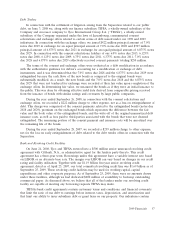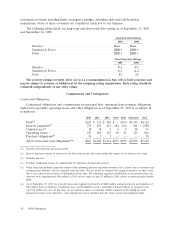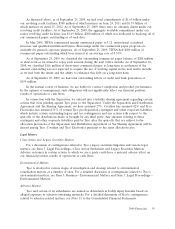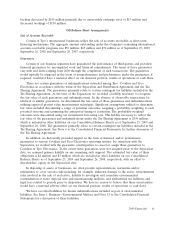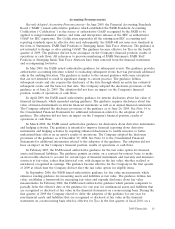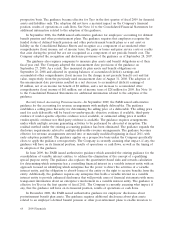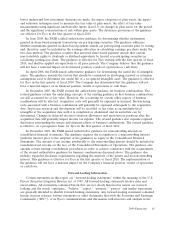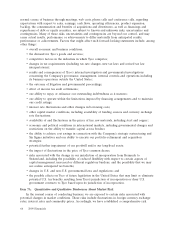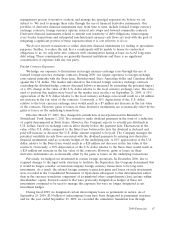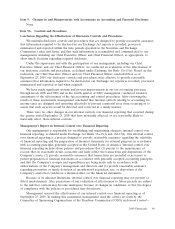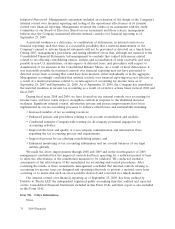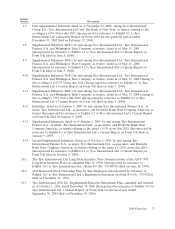ADT 2009 Annual Report Download - page 156
Download and view the complete annual report
Please find page 156 of the 2009 ADT annual report below. You can navigate through the pages in the report by either clicking on the pages listed below, or by using the keyword search tool below to find specific information within the annual report.prospective basis. The guidance became effective for Tyco in the first quarter of fiscal 2009 for financial
assets and liabilities only. The adoption did not have a material impact on the Company’s financial
position, results of operations or cash flows. See Note 14 to the Consolidated Financial Statements for
additional information related to the adoption of the guidance.
In September 2006, the FASB issued authoritative guidance for employers’ accounting for defined
benefit pension and other postretirement plans. The guidance requires that employers recognize the
funded status of defined benefit pension and other postretirement benefit plans as a net asset or
liability on the Consolidated Balance Sheets and recognize as a component of accumulated other
comprehensive (loss) income, net of income taxes, the gains or losses and prior service costs or credits
that arise during the period but are not recognized as a component of net periodic benefit cost. The
Company adopted the recognition and disclosure provisions of the guidance as of September 28, 2007.
The guidance also requires companies to measure plan assets and benefit obligations as of their
fiscal year end. The Company adopted the measurement date provisions of the guidance on
September 27, 2008. As a result, Tyco measured its plan assets and benefit obligations on
September 26, 2008 and adjusted its opening balances of accumulated (deficit) earnings and
accumulated other comprehensive (loss) income for the change in net periodic benefit cost and fair
value, respectively, from the previously used measurement date of August 31, 2008. The adoption of
the measurement date provisions resulted in a net decrease to accumulated (deficit) earnings of
$5 million, net of an income tax benefit of $2 million, and a net increase to accumulated other
comprehensive (loss) income of $61 million, net of income taxes of $28 million for 2009. See Note 16
to the Consolidated Financial Statements for additional information related to the adoption of the
guidance.
Recently Issued Accounting Pronouncements—In September 2009, the FASB issued authoritative
guidance for the accounting for revenue arrangements with multiple deliverables. The guidance
establishes a selling price hierarchy for determining the selling price of a deliverable. The selling price
used for each deliverable will be based on vendor-specific objective evidence if available, third-party
evidence if vendor-specific objective evidence is not available, or estimated selling price if neither
vendor-specific evidence nor third-party evidence is available. The guidance requires arrangements
under which multiple revenue generating activities to be performed be allocated at inception. The
residual method under the existing accounting guidance has been eliminated. The guidance expands the
disclosure requirements related to multiple-deliverable revenue arrangements. The guidance becomes
effective for revenue arrangements entered into or materially modified beginning in fiscal 2011, with
early adoption permitted. The guidance applies on a prospective basis unless the Company specifically
elects to apply the guidance retrospectively. The Company is currently assessing what impact, if any, the
guidance will have on its financial position, results of operations or cash flows, as well as the timing of
its adoption of the guidance.
In June 2009, the FASB issued authoritative guidance which amended the existing guidance for the
consolidation of variable interest entities, to address the elimination of the concept of a qualifying
special purpose entity. The guidance also replaces the quantitative-based risks and rewards calculation
for determining which enterprise has a controlling financial interest in a variable interest entity with an
approach focused on identifying which enterprise has the power to direct the activities of a variable
interest entity, and the obligation to absorb losses of the entity or the right to receive benefits from the
entity. Additionally, the guidance requires any enterprise that holds a variable interest in a variable
interest entity to provide enhanced disclosures that will provide users of financial statements with more
transparent information about an enterprise’s involvement in a variable interest entity. The guidance is
effective for Tyco in the first quarter of fiscal 2011. The Company is currently assessing what impact, if
any, that the guidance will have on its financial position, results of operations or cash flows.
In December 2008, the FASB issued authoritative guidance for employers’ disclosures about
postretirement benefit plan assets. The guidance requires additional disclosures about plan assets
related to an employer’s defined benefit pension or other post-retirement plans to enable investors to
64 2009 Financials





